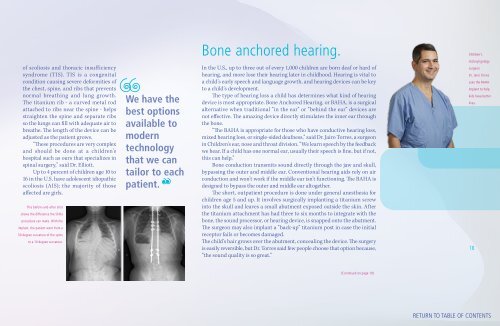Wellness, revolutionized. - Children's Hospital Central California
Wellness, revolutionized. - Children's Hospital Central California
Wellness, revolutionized. - Children's Hospital Central California
Create successful ePaper yourself
Turn your PDF publications into a flip-book with our unique Google optimized e-Paper software.
of scoliosis and thoracic insufficiency<br />
syndrome (TIS). TIS is a congenital<br />
condition causing severe deformities of<br />
the chest, spine, and ribs that prevents<br />
normal breathing and lung growth.<br />
The titanium rib - a curved metal rod<br />
attached to ribs near the spine - helps<br />
straighten the spine and separate ribs<br />
so the lungs can fill with adequate air to<br />
breathe. The length of the device can be<br />
adjusted as the patient grows.<br />
“These procedures are very complex<br />
and should be done at a children’s<br />
hospital such as ours that specializes in<br />
spinal surgery,” said Dr. Elliott.<br />
Up to 4 percent of children age 10 to<br />
16 in the U.S. have adolescent idiopathic<br />
scoliosis (AIS); the majority of those<br />
affected are girls.<br />
This before-and-after shot<br />
shows the difference the Shilla<br />
procedure can make. With the<br />
implant, the patient went from a<br />
50 degree curvature of the spine<br />
to a 10 degree curvature.<br />
We have the<br />
best options<br />
available to<br />
modern<br />
technology<br />
that we can<br />
tailor to each<br />
patient.<br />
Bone anchored hearing.<br />
In the U.S., up to three out of every 1,000 children are born deaf or hard of<br />
hearing, and more lose their hearing later in childhood. Hearing is vital to<br />
a child’s early speech and language growth, and hearing devices can be key<br />
to a child’s development.<br />
The type of hearing loss a child has determines what kind of hearing<br />
device is most appropriate. Bone Anchored Hearing, or BAHA, is a surgical<br />
alternative when traditional “in the ear” or “behind the ear” devices are<br />
not effective. The amazing device directly stimulates the inner ear through<br />
the bone.<br />
“The BAHA is appropriate for those who have conductive hearing loss,<br />
mixed hearing loss, or single-sided deafness,” said Dr. Jairo Torres, a surgeon<br />
in Children’s ear, nose and throat division. “We learn speech by the feedback<br />
we hear. If a child has one normal ear, usually their speech is fine, but if not,<br />
this can help.”<br />
Bone conduction transmits sound directly through the jaw and skull,<br />
bypassing the outer and middle ear. Conventional hearing aids rely on air<br />
conduction and won’t work if the middle ear isn’t functioning. The BAHA is<br />
designed to bypass the outer and middle ear altogether.<br />
The short, outpatient procedure is done under general anesthesia for<br />
children age 5 and up. It involves surgically implanting a titanium screw<br />
into the skull and leaves a small abutment exposed outside the skin. After<br />
the titanium attachment has had three to six months to integrate with the<br />
bone, the sound processor, or hearing device, is snapped onto the abutment.<br />
The surgeon may also implant a “back-up” titanium post in case the initial<br />
receptor fails or becomes damaged.<br />
The child’s hair grows over the abutment, concealing the device. The surgery<br />
is easily reversible, but Dr. Torres said few people choose that option because,<br />
“the sound quality is so great.”<br />
(Continued on page 19)<br />
Children’s<br />
otolaryngology<br />
surgeon<br />
Dr. Jairo Torres<br />
uses the BAHA<br />
implant to help<br />
kids have better<br />
lives.<br />
18<br />
RETURN TO TABLE OF CONTENTS


